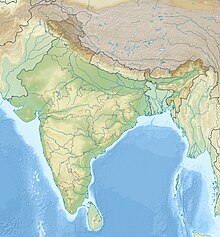नाणेघाट
नाणेघाट पश्चिमी घाट में स्थित एक पर्वतीय दर्रा है जो कोंकण समुद्रतट और 'जुन्नार' नामक प्राचीन नगर के बीच स्थित है। इसे 'नानाघाट' भी कहते हैं। यह पुणे से १२० किमी उत्तर में तथा मुम्बई से १६५ किमी पूर्व दिशा में स्थित है। [1] यह एक प्राचीन व्यापारिक मार्ग पर स्थित है{sfn|Theo Damsteegt|1978|p=206, Quote: "A Hinduist inscription that is written in MIA dialect is found in a Nanaghat cave. In this respect, reference may also be made to a MIA inscription on a Vaishnava image found near the village Malhar in Madhya Pradesh which dates back to about the same age as the Nanaghat inscription."; see also page 321 note 19}} ये अभिलेख ईसापूर्व दूसरी शताब्दी या ईसापूर्व प्रथम शताब्दी के हैं जब सातवाहन राजवंश का शासन था। [2][3][4] ये अभिलेख वैदिक और हिंदू देवताओं और प्राचीन सातवाहन के बारे में जानकारी देते हैं। [3][5] इस अभिलेख में "२, ४, ६, ७ और ९" के लिए विश्व का सबसे प्राचीन अंक संकेत खुदे हैं जो आधुनिक काल के नागरी अंकों से मिलते-जुलते हैं।[4][6][7]
| नाणेघाट गुफा अभिलेख नाणेघाट | |
|---|---|
 नाणेघाट का भूगोल और अभिलेख | |
|
| |
| वैकल्पिक नाम | नाणेघाट गुफाएँ |
| स्थान | महाराष्ट्र, भारत |
| क्षेत्र | पश्चिमी घाट |
| निर्देशांक | 19°17′31.0″N 73°40′33.5″E / 19.291944°N 73.675972°Eनिर्देशांक: 19°17′31.0″N 73°40′33.5″E / 19.291944°N 73.675972°E |
| प्रकार | Caves, trade route passage |
| इतिहास | |
| निर्माता | Queens, Satavahana dynasty -Naganika |
| पदार्थ | Natural rock |
| स्थापित | 2nd-century BCE |
| संस्कृति | Hinduism |
| प्रबंधन | Archaeological Survey of India |
सन्दर्भ
संपादित करें- ↑ Georg Bühler 1883, पृ॰प॰ 53-54.
- ↑ Richard Salomon 1998, पृ॰ 144.
- ↑ अ आ Upinder Singh 2008, पृ॰प॰ 381-384.
- ↑ अ आ Development Of Modern Numerals And Numeral Systems: The Hindu-Arabic system Archived 2017-12-29 at the वेबैक मशीन, Encyclopaedia Britannica, Quote: "The 1, 4, and 6 are found in the Ashoka inscriptions (3rd century bce); the 2, 4, 6, 7, and 9 appear in the Nana Ghat inscriptions about a century later; and the 2, 3, 4, 5, 6, 7, and 9 in the Nasik caves of the 1st or 2nd century CE — all in forms that have considerable resemblance to today’s, 2 and 3 being well-recognized cursive derivations from the ancient = and ≡."
- ↑ Carla Sinopilo 2001, पृ॰प॰ 168-169.
- ↑ David E. Smith 1978, पृ॰प॰ 65-68.
- ↑ Norton 2001, पृ॰प॰ 175-176.

